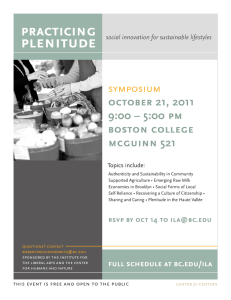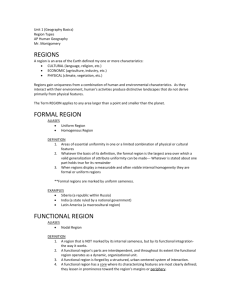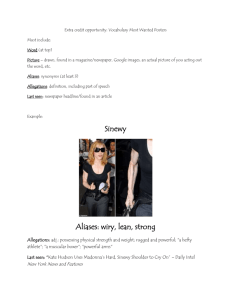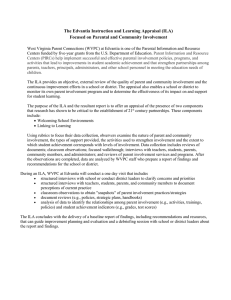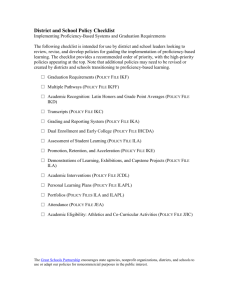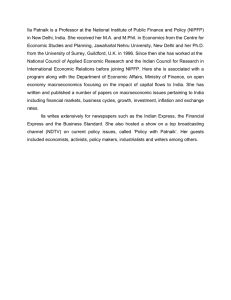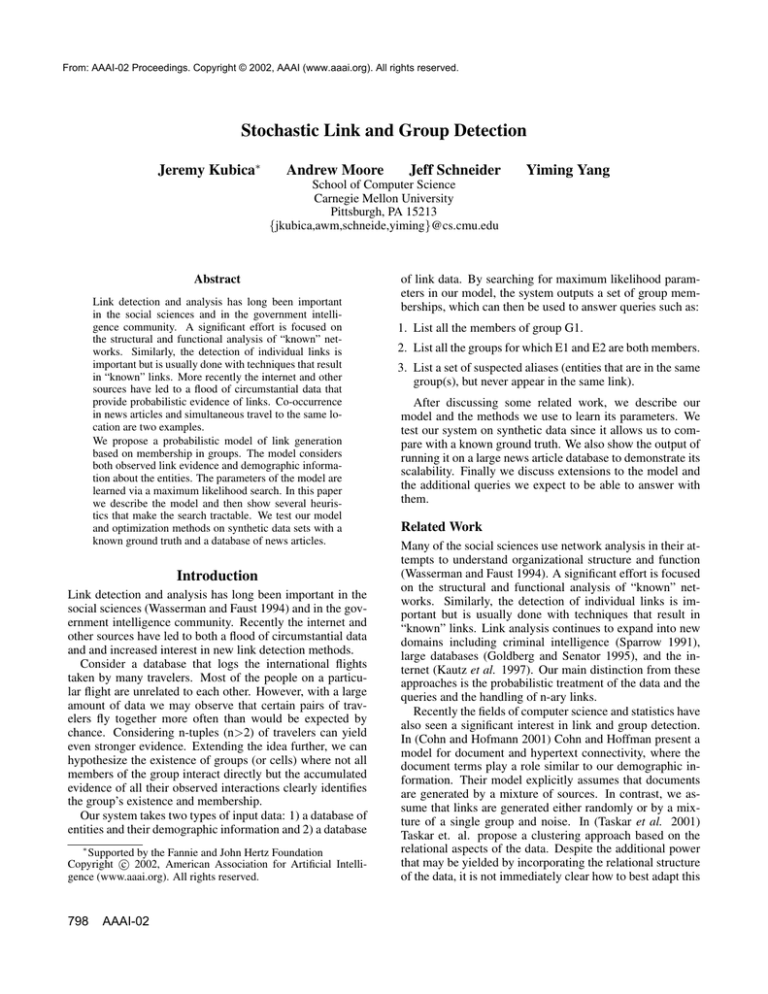
From: AAAI-02 Proceedings. Copyright © 2002, AAAI (www.aaai.org). All rights reserved.
Stochastic Link and Group Detection
Jeremy Kubica∗
Andrew Moore
Jeff Schneider
Yiming Yang
School of Computer Science
Carnegie Mellon University
Pittsburgh, PA 15213
{jkubica,awm,schneide,yiming}@cs.cmu.edu
Abstract
Link detection and analysis has long been important
in the social sciences and in the government intelligence community. A significant effort is focused on
the structural and functional analysis of “known” networks. Similarly, the detection of individual links is
important but is usually done with techniques that result
in “known” links. More recently the internet and other
sources have led to a flood of circumstantial data that
provide probabilistic evidence of links. Co-occurrence
in news articles and simultaneous travel to the same location are two examples.
We propose a probabilistic model of link generation
based on membership in groups. The model considers
both observed link evidence and demographic information about the entities. The parameters of the model are
learned via a maximum likelihood search. In this paper
we describe the model and then show several heuristics that make the search tractable. We test our model
and optimization methods on synthetic data sets with a
known ground truth and a database of news articles.
Introduction
Link detection and analysis has long been important in the
social sciences (Wasserman and Faust 1994) and in the government intelligence community. Recently the internet and
other sources have led to both a flood of circumstantial data
and and increased interest in new link detection methods.
Consider a database that logs the international flights
taken by many travelers. Most of the people on a particular flight are unrelated to each other. However, with a large
amount of data we may observe that certain pairs of travelers fly together more often than would be expected by
chance. Considering n-tuples (n>2) of travelers can yield
even stronger evidence. Extending the idea further, we can
hypothesize the existence of groups (or cells) where not all
members of the group interact directly but the accumulated
evidence of all their observed interactions clearly identifies
the group’s existence and membership.
Our system takes two types of input data: 1) a database of
entities and their demographic information and 2) a database
∗
Supported by the Fannie and John Hertz Foundation
c 2002, American Association for Artificial IntelliCopyright gence (www.aaai.org). All rights reserved.
798
AAAI-02
of link data. By searching for maximum likelihood parameters in our model, the system outputs a set of group memberships, which can then be used to answer queries such as:
1. List all the members of group G1.
2. List all the groups for which E1 and E2 are both members.
3. List a set of suspected aliases (entities that are in the same
group(s), but never appear in the same link).
After discussing some related work, we describe our
model and the methods we use to learn its parameters. We
test our system on synthetic data since it allows us to compare with a known ground truth. We also show the output of
running it on a large news article database to demonstrate its
scalability. Finally we discuss extensions to the model and
the additional queries we expect to be able to answer with
them.
Related Work
Many of the social sciences use network analysis in their attempts to understand organizational structure and function
(Wasserman and Faust 1994). A significant effort is focused
on the structural and functional analysis of “known” networks. Similarly, the detection of individual links is important but is usually done with techniques that result in
“known” links. Link analysis continues to expand into new
domains including criminal intelligence (Sparrow 1991),
large databases (Goldberg and Senator 1995), and the internet (Kautz et al. 1997). Our main distinction from these
approaches is the probabilistic treatment of the data and the
queries and the handling of n-ary links.
Recently the fields of computer science and statistics have
also seen a significant interest in link and group detection.
In (Cohn and Hofmann 2001) Cohn and Hoffman present a
model for document and hypertext connectivity, where the
document terms play a role similar to our demographic information. Their model explicitly assumes that documents
are generated by a mixture of sources. In contrast, we assume that links are generated either randomly or by a mixture of a single group and noise. In (Taskar et al. 2001)
Taskar et. al. propose a clustering approach based on the
relational aspects of the data. Despite the additional power
that may be yielded by incorporating the relational structure
of the data, it is not immediately clear how to best adapt this
A Probabilistic Model of Group Membership
and Link Generation
The goal of the algorithm is to find groupings of people
given demographics and link data. Here, as in many clustering algorithms, the number of groups is given by the user
and the groupings are then “discovered” so as to optimize
some criteria. To this end, our proposed model is designed
to capture a fairly diverse and noisy link generation process.
Given this generative model, the algorithm attempts to find
the groupings that maximize the probability of having seen
the input. Figure 1 shows the model, which takes the form
of a Bayesian network.
Our problem is simply stated: Given evidence in the form
of observed demographic data and observed link data, find
the most likely values of the three remaining data structures in the three remaining network nodes: the demographic
model, the link model, and most importantly, the chart.
We will now proceed to describe each component of the
network.
Figure 1: Probabilistic model of group membership and link
generation. Dashed borders indicated hidden information
and solid borders indicate observed data
• Demographic Data (DD). DD contains all the people under consideration and their demographic information. The
word “demographic” should not be interpreted too narrowly as it can include any information available about
that person. In fact, neither the algorithm nor our software
implementation assumes a pre-specification of its fields.
DD is an observed node.
problem into a well-defined and powerful relational structure. In (Gibson et al. 1998) Gibson et. al. discuss the use
of hyperlink information to find “web communities”. Their
technique makes use of the inherent directionality of hyperlinks to define hubs and authorities. In contrast, we examine
links without this directional property and thus do not make
use of the concept of hubs and authorities. For example, the
concept of a authority does not have a well defined meaning
when talking about a list of people seen at lunch together.
• Demographic Model (DM). DM is a model predicting
group membership for each of NG possible groups. Note
that instead of one classifier predicting a NG -valued output, we have NG classifiers, the i’th of which predicts
the True/False-valued output of whether the person is in
Group i. This allows people to be in multiple groups.
Our current model is very simple: we assume that group
memberships are conditionally independent of each other
given demographics. Further, our classifiers are also simple: they are merely naive Bayes classifiers. In later work
both of the preceding assumptions may be relaxed if the
statistics warrant.
DM is a hidden node.
While our approach is similar to those above, the main
difference is in how we structure the generative model. We
assume links a generated as noisy subsets of group members
who have definite group membership. To this end, our model
is designed to easily and directly capture the group membership nature of the data, including the fact that a person can
be a member of many groups.
One approach we have elected to avoid is a mixture model
in which each person is assumed to belong to a single hidden
group that must be inferred from data. This model (which
could be implemented as a simple mixture model) would allow evidence to associate a person probabilistically with any
group (caused for example by a political party affiliation, for
example). But as the evidence for that group membership
increased it would by definition push down the probabilities for competing groups (e.g. a coffee-shop they may frequent). In the limit of infinite data everyone would each be a
member of only one group. In contrast, the model presented
here will allow simultaneous high confidence membership
in many groups.
• Chart (CH). The Chart represents which people are in
which groups. The generative model assumes that memberships of people in groups within the chart has been determined by, for each group g and each person p:
1. Look up p’s demographics in DD.
2. Use DM to predict P (p ∈ g | p’s demographics).
3. Randomly choose whether p ∈ g according to this
probability.
We can thus easily define log P (CH|DM, DD) as:
log P (CH|DM,
DD) =
log P (p ∈ G|DM , p’s dems)
p∈G
p
G
log (1 − P (p ∈ G|DM , p’s dems)) p ∈
G
CH is a hidden node.
• Link Model (LM). LM consists of various parameters
(introduced when we define Link Data) used to determine
AAAI-02
799
the probabilities of various observed links. LM is a hidden node.
• Link Data (LD). The second piece of input, the link
database (LD), is a set of records specifying n-tuples of
entities that are linked by some event. Again, the word
“link” should not be interpreted too narrowly as the event
may be as circumstantial as their having simultaneously
traveled to the same country.
Further, our definition of a link is as an inherently noisy
piece of information. We explicitly provide for two different types of noise. Specifically, links are generated assuming that it is possible to have both completely random
links (Innocent Link Assumption) and group generated
links that contain random non-group members (Innocent
Link Member Assumption). We interchangeably use the
terms “innocent” and “guilty” to mean “coincidental” and
“indicative of a true linkage.” These two types of innocence are captured by the probabilities PI and PR , which
represent the probability of an innocent link and the probability of a innocent (random) link member respectively.
Another important aspect of the model is the incorporation of different link types. Each link type is assumed
to have a different set of properties, the values PI and PR
which are recorded in the Link Model (LM). For example,
the link that captures people being in the same city can be
expected to have significantly higher PI then a link that
captures a monetary transaction.
P (LD|LM, CH) is defined generatively by declaring
that a link L between k people from a link type with parameters PI and PR is generated as:
– With probability PI : place k random, unique people
into L.
– Else with probability (1 − PI ) :
∗ Randomly choose a group G from the set of groups
that have at least k people.
∗ While |L| < k
· With probability PR add a random person who is not
a member of G, p ∈
/ G and p ∈
/ L, to L.
· Else with probability (1−PR ) add a random member
of G, p ∈ G and p ∈
/ L, to L.
We make the simplifying assumption that the priors for
each group generating a link are equal. This allows us to
calculate log P (LD|LM, CH) as:
log
P (LD|LM,
CH)
= LinkT ype L∈LinkT ype log P (L|LM, CH)
(1)
where P (L|LM, CH) is the probability of an individual
link given the link model and the chart and, under the
above generative assumptions, is:
PI
1 − PI P (L|LM, CH) = NP +
P (L|G, LM )
NG
|L|
G
P (L|G, LM ) is the probability that link L was generated
given that group G generated it and is defined as below
in (2). Note in the equation below, K1 is the number of
people in the link that are members of group G and K2 is
800
AAAI-02
the number of people in the link that are not members of
G.
P (L|G, LM ) =
2
(PR )K2 (1 − PR )K1 K1K+K
1
(2)
|G|N −|G|
K1
K2
One important possible approximation is shown in (3).
This allows the concept of a group “owning” a link and
can lead to significant computational speedups as discussed below. It makes the assumption that for each link
L, there is usually overwhelming evidence of which group
generated the link, or else overwhelming evidence that the
link was generated randomly. Thus the approximation assumes that just one of the probabilities in 2 dominates all
the others.
log P (L|LM,
CH)
≈ logM AX
PI
(N|L|P )
,
1−PI
NG M AXG (P (L|G, LM ))
(3)
Fitting the hidden nodes
We wish to find
argmax
P (LM, CH, DM |DD, LD) =
LM, CH, DM
argmax
P (LM,CH,DM,DD,LD)
P (DD,LD)
LM, CH, DM
argmax
LM, CH, DM
argmax
LM, CH, DM
=
P (LM, CH, DM, DD, LD) =
P (LD|LM, CH)P (LM )×
P (CH|DM, DD)P (DM )P (DD)
where the second step is justified by noticing that P(DD,LD)
is constant within the argmax. By noting that P(DD) is also
constant, and by assuming a uniform prior over LM and DM,
we see we need to find
argmax
LM, CH, DM
argmax
CH
(
max
LM
P (LD|LM, CH)P (CH|DM, DD) =
P (LD|LM, CH))(
max
DM
P (CH|DM, DD))
Thus the outer loop of our search is over charts, and for each
new chart we quickly compute the value of LM that maximizes the likelihood of the LD the value of DM that maximizes the likelihood of CH.
At each iteration of optimization, one or more changes
are made to the chart. The MLE DM is then calculated directly from the new chart and the DB—this is very
fast for a naive Bayes LM. The LM can also be optimized using a simple EM update, although for the experiments described below the LM was held fixed. Finally,
log P (LM, CH, DM |DD, LD) is calculated. The difference between the two log-likelihoods represents the improvement, or lack there of, in making that change.
In future work we will evaluate the extent to which our
current direct optimization approach could be accelerated by
an EM algorithm.
Stochastic hill-climbing was used for optimization. In addition, the model described above was designed to be optimization friendly. For example, by allowing links generated
by group g to probabilistically have some non-g participants,
the optimization is able to fill in groups one person at a time
and see incremental improvements in likelihood.
The optimization method used was a noisy hill climbing method.
Specifically, at each iteration a bit
(p, g) in the chart was flipped and the new score
log P (LM, CH, DM |DD, LD) was calculated. Moves resulting in improvement were always accepted and all other
moves were accepted with some probability Pworse . It was
found that looking at a number of neighbors before “committing” one, greatly improves performance. Looking at
more neighbors per iteration allows the search to more thoroughly explore the immediate neighborhood. At the limit
where the search examines all neighbors, the optimization
becomes gradient descent.
It is also important to note that when using such an optimization method, the max approximation shown in (3)
can lead to significant computational speedups. These
speedups result from the fact that for a given (p, g, t) flip
∆log P (LD|LM, CH) can be approximated by looking at
log P (L|G, LM ) for only a few groups instead of all of the
groups. Specifically, for each link ∆log P (L|LM, CH) can
be approximated as:
∆log P (L|LM,
CH) ≈ P (L|GM AX , LM )OLD −M AX P (L|GM AX , LM ), P (L|g, LM ), NPPI
( |L| )
where GM AX was the most probable group to have generated link L before the flip and P (L|GM AX , LM )OLD
was its score before the flip. In other words, the change
in the probability of a link can be approximated by the three
cases: the former GM AX still “owns” the link, group g now
“owns” the link, or it is more probable that the link is now
“innocent”. Thus, approximating ∆log P (LD|LM, CH)
for multiple neighbors can be done in time independent of
the number of groups, NG . This independence can lead
to an O(NG ) speedup for examining neighbors. Additional speedups can also be gained by caching GM AX and
P (L|GM AX , LM )OLD for each link.
Empirical results
Tubeworld
Initial tests were performed on a simulated world called
Tubeworld. Tubeworld, shown in Figure 2, consists of a finite two dimensional world where people occupy randomly
generated points. Each group is defined by a parallelogram
and consists of all people whose location falls within this
parallelogram. Groups can overlap and are assumed to contain at least two members. The small rectangles in Figure
2 represent the people and are color-coded according to the
groups to which a person belongs. The real-valued (x,y)coordinates of the people are hidden from the algorithm.
Demographic information consists of breaking the X and
Y world coordinates into D discrete blocks, giving a total
of D2 possible demographic labelings. Finally, the NL links
Figure 2: Example tubeworld with 100 people and 4 groups.
are generated based on the groups and according the the generating assumption given above.
Tubeworld Results
The tests consisted of 50 randomly generated tubeworlds,
each containing 100 people, 4 groups, and 1000 links. Runs
using the Innocent Link Assumption (ILA) and/or Innocent
Link Member Assumption (ILMA) used the values PI =
0.1 and PR = 0.1. The charts produced are the result of set
number of optimization iterations.
In order to compare the performance of the algorithm using various combinations of the ILA and the ILMA, a 4 by
4 test was used. For each tubeworld the linkbase was generated using each possible combination of ILA and ILMA,
namely: ILA + ILMA, ILA, ILMA, none. In addition, for
each such linkbase the chart was learned using each possible
combination of ILA and ILMA. For each generating/learned
pair, error in the learned chart was calculated as the difference in the log-likelihood of the learned chart and the loglikelihood of the generating chart. The average errors are
shown in Table 1. The columns represent the different learning methods and the rows represent the different generation
methods. Note that larger, less negative, numbers indicate
better performance.
In addition, we examined a second performance metric, a
paired membership error test. This test looked at all possible pairs of people and all groups. The error between two
charts for each pair of people, p1 and p2 , is defined as the
absolute value of the difference between the number groups
in each chart that contain both p1 and p2 . The total error between two charts is the sum of errors for each pair of people.
Thus, if two charts are identical this error would be zero,
because each pair of people would belong to the same number of groups in both charts. This test has the advantages of
AAAI-02
801
True
World:
ILA/ILMA
ILA
ILMA
-
Model
assumes
ILA/ILMA
-89.0
-84.5
-36.7
-169.6
Model
assumes
ILA
-543.7
-338.9
-602.9
-336.2
Model
assumes
ILMA
-159.2
-186.1
-101.7
-306.1
Model
assumes
neither
-3134.0
-3194.6
-3271.6
-1505.4
Table 1: Log-likelihood error rates for charts learned. The
rows and columns represent the probability assumptions for
generation and learning respectively.
being simple, computationally cheap, and providing a good
measure of the difference between two charts. The average
error for each of the 16 probability assumptions are given in
Table 2 below.
True
World:
ILA/ILMA
ILA
ILMA
-
Model
assumes
ILA/ILMA
316.5
132.5
91.4
34.1
Model
assumes
ILA
2102.3
877.2
1576.5
160.3
Model
assumes
ILMA
930.1
626.7
165.6
47.8
Model
assumes
neither
7700.0
4940.1
5836.1
813.0
Table 2: Paired person error rates for charts learned. The
rows and columns represent the probability assumptions for
generation and learning respectively.
While the results of the 16x16 pairwise significance tests
are omitted for space considerations, we do examine the significance in the success of the learners using the ILMA/ILA
versus other learners. Specificaly, we examine the statistical significance of the difference in mean paired person
error rates between column 1 and the other columns for a
given row. With two exceptions, the differences in the mean
paired person errors between the models learned using the
ILMA/ILA and all other assumptions were statistically significant, using α = 0.05. The two exceptions were that
when the True World was “ILMA” or “Neither” then there
is no significant difference between the scores for “Learner
ILMA” and Learner “ILMA/ILA”.
From Table 1 and Table 2 we can see the relative performance of the different learners on linkbases generated
by different methods. On average, learners using both the
ILMA and ILA performed better than the other learners.
This supports the belief that incorporating both forms of innocence allows the model to represent a wider range of underlying generation models while not harming performance
on simpler models.
The results reveal that assuming only guilty links but innocent link members leads to superior performance over assuming innocent links and no guilty link members. One reason for this might be the fact that under the ILMA if link
sizes are small, random links may still be attributed to a
group to which one of the link members belongs. Thus,
although the link is innocent, the ILMA can account for it
as a guilty link with a few innocent members. This may
802
AAAI-02
be important in cases where a search is adding members to
a group. Another important trend is the poor performance
of the learners that do not assume either type of innocence.
Since they do not make either assumption, the link data is assumed to be noiseless. This assumption is inherently flawed
when working with real world data.
It is also interesting to note the extent to which the optimization friendly assumption of the previous section was
important. On average the learners using both the ILMA
and ILA outperformed the other learners regardless to how
the linkbases were generated. One example of this benefit is
as follows. A pair of people might be in a group together,
but initially be placed in the wrong group. Assuming they
have a large number of links in common, removing one of
them may result in a drastic worsening in score. Using the
ILMA and the ILA might reduce this problem, because some
of these links can temporarily be accounted for by innocent
interactions until both people are moved.
Finally, it is interesting to note that performance of all
learners on charts generated using ILMA and ILA is worse
than on charts generated with other assumptions. This suggests an increased difficulty of these problems arising from
the larger amount of noise in the linkbase.
News article experiments
In order to test scalability and performance on real data, we
ran our algorithms on a database of news articles. The data
is part of a benchmark evaluation collection named Reuters
Corpus Volume I and contains over 800,000 news stories
from Reuters between August 1996 and August 1997. The
corpus has been used by the 2001 Text Retrieval Conference
(TREC-10) for the evaluation of document filtering methods. For our tests we selected a subset of approximately
35,000 articles.
Automated extraction of named entities, such as Person,
Organization, Location, Date and Time, has been successfully applied to many information extraction problems since
its initial success in the Message Understanding Conferences (MUC) (Borthwick et al. ). A Hidden Markov Model
(HMM) approach by BBN is one of the most successful
methods, which obtained a performance of 96% on the F1
measure (the harmonic average of recall and precision) on
English documents in a MUC evaluation(Bikel et al. 1997).
We applied a pre-trained BBN HMM model to automatically
extract person’s proper names from the articles.
We then treated each article as a link between all of the
people mentioned in the article. We preprocessed the results
by excluding all articles that referred to less than two people.
Following that, we also eliminated any people that were not
referred to by any articles with at least two people in them.
The final result was a database of 9000 entities and a set of
9913 (2-ary or higher) links relating them to each other.
Sample results. After some manual experimentation we
found 30 to be a good number of groups for this data set. It
turned out that most of the 9000 entities were not mentioned
frequently enough to merit their inclusion in groups. After
about two hours of optimization on a 1 Gigahertz Pentium,
some examples of the groups found are:
G2 (john major,dick spring,ernesto
zedillo,zedillo,richard alston,sabah, abdus samad
azad,stella mapenzauswa,finmin,mccurry,viktor
klima,ron woodward, alexander smith,iss price,glenn
somerville,yevgeny primakov,washington, joan
gralla,bernie fraser,stahl,danka,sally,palladium,van
der biest,fausto)
G22 (clinton,blair,tom brown,ernesto
zedillo,leon,neumann,h.d.
deve gowda, rob davies,karmen
korbun,fran,consob,saharan blend,englander,garcia,
bruce dennis,jonathan lynn,laurence lau,h.
carl mc-
call,fraser, anne vleminckx,delphis,collin co,elaine
hardcastle,alain van der biest, david martin)
These groups illustrate some successes and remaining issues. The name Washington appears in group G2, but in fact
was misidentified as a person’s name by the named entity
extraction software. Similarly, ISS price is a technical label
used in quoting various financial instruments. A larger problem is the frequent occurence of single name entities. This
happens when the writer uses only a first or last name to refer to a person and effectively results in numerous aliases
appearing in the database. In some cases the connection is
found. For example, Ernesto Zedillo appears with Zedillo in
G2. However, the match is not made in G22 and Bill Clinton
is also not included in G22 with Clinton.
Despite these difficulties, several interesting patterns appear in the groups. G22 contains the leaders of the US,
the UK, and Mexico. It also illustrates an unintended result. Tom Brown and Jonathan Lynn are writers. Many of
the groups ended up consisting of a combination of various
writers and the subjects they most often wrote about. Writers ended up being linked by writing about common subjects
and subjects ended up being linked even when not appearing in the same article, by being written about by the same
person.
Detecting aliases. As already mentioned, the intentional
or unintentional use of aliases presents a serious problem
for link detection algorithms. As a first step toward identifying aliases we consider a specific type: single user, non-cooccurring aliases. These are aliases used by only one individual and have the property that they never appear together
in the same link. This type of alias is a poor model for what
happens in news articles, but may be a very good model for
the use of fake passports for example. Provided the fake
passport is not shared with others, you do not expect to see
the real and the fake passport to be used for entry to the same
country in a short period of time or for them both to be used
to board the same commercial flight.
We propose a simple algorithm to detect these types of
aliases. We search for pairs of individuals that are placed
in the same group, but never appear together in any link.
We rank these hypothesized aliases according to the size of
the group in which they appear. In general, membership in
smaller groups is a stronger indication of a link between two
entities.
Ideally, we could test our algorithm by identifying some
of the aliases already existing in the news article data and
checking if our algorithm can find them. Since the only
method we know of doing this is the manual identification
of the aliases we chose an alternative test. We automatically
generated aliases for a random set of 450 of the 9000 entities
in the database. In each case, we went through the link data
referring to each of those 450. For each link, with probability 50%, we substituted the name of the entity with its alias.
In this case, we were rarely able to detect the aliases. The
problem is that most of the 9000 entities appear in very few
links. Taking the small number of links and cutting them in
half (by relabeling half of them to be the newly created alias)
made it difficult to even get these entities into appropriate
groups, much less identify which were aliases for each other.
Unfortunately, this is exactly the real problem encountered
when doing link detection in the face of aliases.
To simplify the task, we selected only the entities with
at least 10 links in the database (there are 273) and made
aliases for them. The following table shows the results of
the alias detection algorithm:
True aliases:
273
Hypothesized aliases: 57849
Group rank False Negatives
0
272
1
272
2
271
3
269
4
268
5
263
6
263
7
260
8
258
9
256
False Pos
76
190
628
2579
5318
12536
21251
30741
44141
57832
The i’th row specifies the number of false positives and
false negatives found when considering the aliases found in
only the groups which are smaller than the i’th group (ranked
according to size). Using all of the groups we see that out
of 273 true aliases, only 17 were found and 57832 false discoveries were made. The high number of false positives is
not necessarily bad. Some of the original names in the news
articles really are aliases as we observed earlier. Also, the
whole purpose of the group model is to identify members
of the same group even though there may be no direct link
evidence between them. Many of the false positives are just
the result of the algorithm doing its job. Finally we observe
that a random selection of 57832 pairs would not expect
to find any of the 273 aliases by chance. Usually an alias
detection algorithm would be used to generate hypothetical
aliases that would be checked by other means.
Research Area Groupings from Web Pages
A third source of test data came from the Carnegie Mellon
University Robotics’ Institute webpages. Specifically, we
looked at the groupings of people within the Robotics’ Institute based purely on their publicly declared research interests. Each person with an official webpage was treated as
an entity. Each link was defined by a single research interest, such as machine learning, and included all people who
listed that interest on their official page. Note that in this
case no demographic information was used, but one could
consider using such information as whether a person is a
faculty member or a student.
AAAI-02
803
The algorithm was run with 8 groups. We expected to
find groupings that roughly matched project groups and lab
groups. The results returned were largely consistent with
people’s declared interests, but were often noisy combinations of several related lab groups and people with similar interests. This is most likely due to the fact that the Robotics’
Institute contains significantly more than 8 lab groups and a
significant number of members of the Robotics’ Institute did
not declare any research interests.
A more illuminating example reverses the above roles of
people and research interests. In this case each research interest is treated as an entity. A link is defined as all of the
entities that appear together under a single person’s research
interests. Again, no demographic information was used.
The algorithm was run with 5 groups and found results that
agree with intuition. For example, two of the groups were:
G0 (actuators, control, field robotics, legged locomotion, manipulation, mechanisms, mechatronics, mobile
robots, motion planning, multi-agent systems, space
robotics)
G4 (animation, graphics, computer vision, visualization, geometric modeling, human-computer interaction,
image compression, image processing, machine learning,
object recognition, pattern recognition, sensor fusion,
stereo vision, video systems, visual tracking)
Note that both of these groups agree with intuition for
a grouping of research areas within the field of robotics.
It is also important to note that many of the items in the
groups, while intuitively similar, did not appear together on
a page. In other words, while some people’s webpages contain many consistent interests such as ”3-D perception, computer vision, mobile robots, and range data”, a large number
of people’s interests contained diverse topics such as ”computer vision, entertainment robotics, machine learning, mobile robots, and obstacle avoidance” or only a incomplete
list of what be considered related interests, such as ”machine
learning” without ”artificial intelligence”.
Discussion
The algorithm described in this paper is only the core of the
link detection and analysis system currently under development. We are working on the following extensions:
Posterior probability distribution of charts. Ultimately, the discovery of the maximum likelihood instantiation of model parameters (even if it could be found), may
not be the most useful result. A more desirable alternative is
a posterior distribution of parameter instantiations. We will
use Markov Chain Monte Carlo (MCMC) methods to generate distributions from which we will be able to answer the
following additional queries:
1. What is the probability that entity E1 is a member of
group G1? This is answered by counting the frequency
of samples for which E1 is in G1.
2. What is the probability that E1 and E2 are in the same
group? Again, simple counting is used.
Dynamic group membership. In reality, we expect entities’ memberships in groups to evolve rather than being
804
AAAI-02
static across all time covered by the link data. A straightforward extension to the chart allows it to represent each
entity’s membership in groups at each discrete time step.
The model is extended such that membership at time t depends probabilistically on the demographic model, the demographic data, and the membership at time t−1. The result
is significantly more parameters in the model, thus making
the optimization more difficult. By solving the computational challenge we hope to obtain more reliable answers to
the queries and their time-based analogs.
Conclusion
We have proposed a generative model for group membership
and link generation. The strength of this model is its ability
to process probabilistic link data and reason probabilistically
about links and group memberships. This approach simultaneously provides the ability to incorporate information about
n-ary (n > 2) links.
We have developed a search method to optimize the parameters of that model given observational data. Our experimental results show the ability of the optimization to identify
groups and links, as well as generating alias hypotheses. The
experimental results and the computation required to generate them show that the performance of the system is still
constrained by the ability of the optimizer to find the best
parameter settings and our future work will focus on scalability. Finally, we have described our plans for a complete
system capable of answering a broad array of probabilistic
queries about links, membership in groups, and aliases.
References
D.M. Bikel, S. Miller, R. Schwartz, and R. Weischedel. Nymble:
a high-performance learning named-finder. In In Fifth Conference
on Applied Natural Language Processing, 1997.
A. Borthwick, J. Sterling, E. Agichtein, and R.Grishman. Description of the mene named entity system as used in muc-7. In
Proceedings of the Seventh Message Understanding Conference
(MUC-7), Fairfx, Virginia.
David Cohn and Thomas Hofmann. The missing link - a probabilistic model of document content and hypertext connectivity. In
Neural Information Processing Systems 13, 2001.
D. Gibson, J. Kleinberg, and P. Raghavan. Inferring web communities from link topology. In Proc. 9th ACM Conference on
Hypertext and Hypermedia, 1998.
H. Goldberg and T. Senator. Restructuring databases for knowledge discovery by consolidation and link formation. In First International Conference on Knowledge Discovery and Data Mining, 1995.
H. Kautz, B. Selman, and M. Shah. The hidden web. AI Magazine, 1997.
M. Sparrow. The application of network analysis to crminal intelligence: an assessment of prospects. Social Networks, 13, 1991.
B. Taskar, E. Segal, and D. Koller. Probabilistic clustering in relational data. In Seventeenth International Joint Conference on
Artificial Intelligence, pages 870–876, Seattle, Washington, August 2001.
S. Wasserman and K. Faust. Social Network Analysis: Methods
and Applications. Cambridge University Press, 1994.

